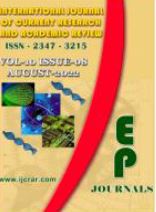Abstract Volume:10 Issue-8 Year-2022 Original Research Articles
 |
Online ISSN : 2347 - 3215 Issues : 12 per year Publisher : Excellent Publishers Email : editorijcret@gmail.com |
2HBT Medical College and RN Cooper Hospital, Mumbai, India
Introduction-Tympanoplasty refers to any operation with/or without reconstruction of tympanic membrane, with/or without ossicular chain reconstruction with or without mastoidectomy to eradicate infection and disease so as to make the ear safe, dry and restore hearing. Different materials have been used to construct the tympanic membrane, the most accepted of which is temporalis fascia autograft and almost always the most favorable graft for its immunologically compatibility. Pure tone audiometry is the gold standard to record pre and postoperative hearing assessment and to compare the result postoperatively. This prospective study is focussed on Tympanoplasty and reconstruction of the hearing mechanism analyzing the audiometric pattern of hearing loss in COM pre- operatively, and assessing the outcome of the surgery after 6 weeks postoperatively. Material & Methods- Prospective observational study carried out for One year 8 Months from February 2018 to October 2019 in a sample size of 50 patients. Detailed history and clinical examination of all these patients were done. Patients were assessed by pure tone audiometry (PTA) and eustachian tube patency was assessed by eustachian tube function test- Toynbee test. Based on the investigations, the necessary intervention were performed as per the existing standards of care and protocols. Patients were followed up in opd at weekly intervals after surgery. All the data was compiled and used for the study. Results-Various pre & postoperative parameters like age, sex, otorrhoea, types of tympanoplasty, hearing assessment were compared. The mean pre and post-operative air conduction threshold in the successful cases are 48.96 and 33.62 respectively with a mean audiological improvement of around 15 db. Thus, our findings are consistent with other studies. In our study, differences between Pre and Post mean values of Air Conduction when tested with Paired T test showed P value <0.01 which is highly significant. Conclusion-Type 1 tympanoplasty is a safe and effective technique to achieve intact tympanic membrane and improve hearing in patients of chronic otitis media tubotympanic type. It helps in improving the quality of life of patients. The most common approach is post aural. The graft uptake rate is better at six weeks. Many factors have been investigated to determine their effect on the tympanic membrane closure rate and hearing improvement. Some studies demonstrated that surgical outcome depends on several factors including size and location of the perforation, ossicular status, type of surgical technique, graft type and function of the Eustachian tube. The study had limitation of small sample size, future study with large sample size and prospective in nature will be more useful. Even though many different factors can influence the results of a tympanoplasty operation, according to the statistical results of the study, there is no significant difference in the outcome of the operation, neither in the health of the tympanic membrane after surgery nor in hearing development.
How to cite this article:
Manisha Sharma, Nilam Sathe and Ninad S. Gaikwad. 2022. Post-Operative Hearing Assessment in Tympanoplasty and Factors Affecting the Outcome.Int.J.Curr.Res.Aca.Rev. 10(8): 13-32doi: https://doi.org/10.20546/ijcrar.2022.1008.002



Quick Navigation
- Print Article
- Full Text PDF
- How to Cite this Article
- on Google
- on Google Scholor
- Citation Alert By Google Scholar
